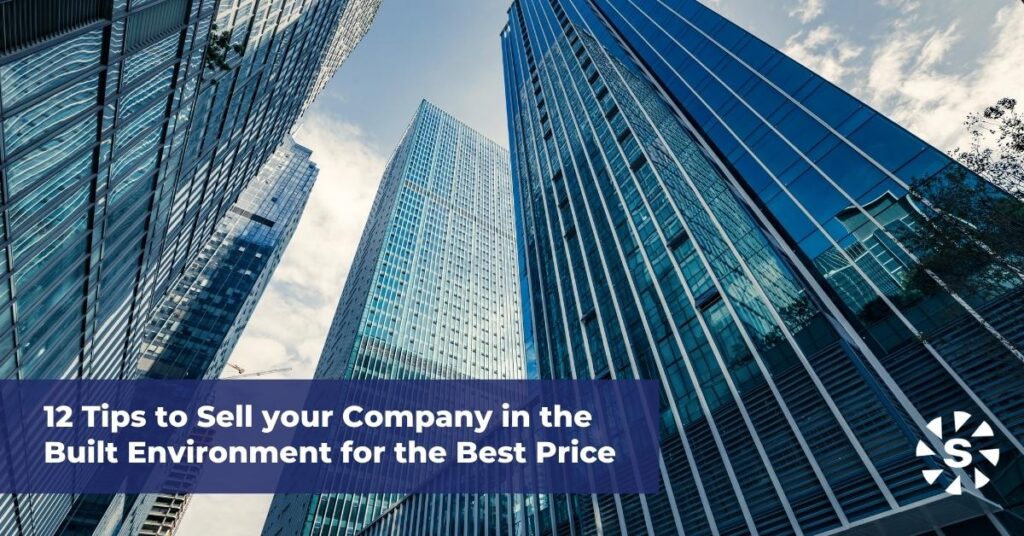
12 Tips to Sell Your Company in the Built Environment for The Best Price

As you contemplate the decision to sell your company in the built environment, it’s important to have a thorough understanding of what to expect. Companies in the built environment can sell from anywhere between a 1.5x – 12x multiple of EBITDA (Earnings before Interest, Taxes & Depreciation), depending on a multitude of factors. There are some obvious factors that determine how much you company is worth, like the net revenues, number of employees, backlog (work under contract), and EBITDA. Outside of those, there are steps you can and should take to get top dollar for your company.
1 – Streamline & Document Wherever You Can
As you get ready to sell your company, take some time to get your financial statements in order and document your backlog and pipeline of work. Sophisticated buyers willing to pay top dollar for your company will want to see a company that has proven systems and processes implemented company wide.
2 – Make Your Business Development Process a Well-Oiled Machine
A big hurdle buyers often have when purchasing a company in the built environment is the business development process. What happens to the new business pipeline when the owner is gone? If the owner holds all the relationships with clients, then how can these relationships be transferred? Even if the owner is willing to stay on board after the transaction for a 2-3 year transition, buyers still don’t like to see companies without a clear business development system in place.
3 – Backlog & Pipeline
Companies with at least 9 months of work under contract generally sell quicker than those that do not. In addition, buyers will want to see that your company has a robust pipeline of work. Pipeline is work that your company is expecting to win but is not under contract as of yet.
4 – Get Your Financials in Order
You need to have an accurate picture of your company’s financials in order to sell your business for the best price. Seems obvious right? To convince a buyer your business is the right purchase for them, you need to know exactly what is coming in and out each month. Now is the time to take your mother-in-law off payroll and remove your business credit card from your Amazon account. Balance Sheets and Profit and Loss Statements for 3 years should be enough to move you on to step 5.
5 – Find A Quality M&A Advisor to Sell Your Company in the Built Environment
This could be the difference between selling your company for the best price or not. A quality advisor who understands your niche and industry (this is key) will be able to give you an accurate valuation, produce professionally designed marketing materials and most importantly, tap into their network of ready-to-go buyers. A great advisor will be worth their weight in gold at the end of this process and will absolutely help you sell your company for the best price.
6 – Figure Out What Your Company in the Built Environment Is Worth
Now that you have a clear understanding of where your company stands financially, it’s time to give it a value. A company is only worth what a buyer is willing to pay for it, but there are some tried and true factors that go into a successful valuation. The company’s net revenues & profits, backlog and pipeline, years in business, financial trends, growth opportunities and the current buyer pool are just a few of the factors that go into determining a valuation of a company in the built environment. This is where it gets a bit tricky, and a good advisor is going to have unparalleled knowledge to value your company correctly.
7 – Develop A Marketing Strategy To Sell Your Company in the Built Environment
Once you know how much your company is worth, it’s time to tell the world about the opportunity to purchase it. There are thousands of businesses that get listed for sale every day, making it imperative that your company is positioned correctly in the marketplace. To get in-front of the right buyers, a unique, full-court-press marketing strategy must be implemented. Think email campaigns, press releases, direct contacts, click-funnel campaigns, paid media, search engine optimization, content marketing and most importantly, relationships. Unsurprising news flash – existing relationships with a pool of seasoned buyers is still the absolute best way to sell your company for the best price.
If you’re using a business broker or M&A advisor, make sure to ask about their existing relationships with buyers in the built environment. They should have solid, and long-standing relationships with seasoned buyers who are always on the look-out for their next opportunity. At Stonemill Partners, over 90% of the companies we sell get sold to an existing buyer in our database. We can’t stress this enough – these relationships are crucial!
8 – Develop Marketing Materials
While some businesses are purchased by first-time business owners, most are purchased by seasoned entrepreneurs & strategic buyers who are approached with dozens of businesses each week. Sending a potential buyer, a traditional Executive Summary just doesn’t cut it anymore. Make sure you have a professionally prepared Confidential Information Memorandum (CIM), which is essentially a presentation overview of your company in PDF format. A CIM is generally 25-30 pages long and answers all of the initial questions that buyers have to help your company stand-out from the crowded marketplace of businesses for sale.
9 – Culture Fit
This is where things start to get interesting…and fun. You’ve put in all of the hard work in order to properly value your company, a marketing strategy has been developed and all of the necessary marketing materials to get your company sold for the best price have been designed and produced. If everything up to this point has been done correctly, you should start getting buyers interested in your company. To successfully sell your company, it’s imperative that all potential buyers match culturally. It is important to confirm the buyer is the right fit for you, your employees, and your clients. This often-overlooked step is so, so important.
Here’s why:
Once a buyer submits a Letter of Intent on your company and you agree to the offer, you almost always enter an exclusive due-diligence period, in which you as the seller are generally not allowed to discuss the sale with other potential buyers. If the first buyer is not the right fit culturally, you very easily could have missed your window of opportunity with another better suited buyer.
10 – Get Creative with Negotiating & Terms
Once the vetting process is complete with a buyer and you feel like they would be a great fit as an owner of your company, you’re in a wonderful position to start negotiating the Letter of Intent (LOI) submitted by the buyer. The LOI includes the price the buyer is willing to pay and the terms in which the amount will be paid.
Buyers almost never come to the table with all-cash deals. More than likely, your buyer will offer terms that mitigate their risk, including suggesting a percentage of owner financing, an earn-out or a staggered purchase overtime.
In order to sell your company for the best price, at the best possible terms, it is imperative that you have a thorough understanding of what your company is worth. How was the valuation determined and what items on your balance sheet will you retain? Understanding this will give you tremendous negotiating power with the buyer and will certainly help you sell your company for the best price.
In addition to negotiating the purchase price, you’ll need to negotiate advantageous terms. It helps if you understand all of the unique ways to structure a business deal so you can make choices in structure that are advantageous to you. When in doubt, use a quality business broker or M&A advisor to help with this…it could be the difference between you selling your company for the best price or not.
11 – Discuss Integration and Transition While In Due-Diligence
Unlike when you sell real estate, buyers and sellers of companies in the built environment almost always work together for at least some predefined period of transition. Getting on the same page about expectations as early in the process will help you manage expectations and show that you are a seller who is dedicated post-sale. Working diligently on combining the two cultures, developing plans for cross-marketing, and integrating the staff positively, will create a synergistic transaction.
12 – Use A M&A Attorney For A Final Review Of Documents
There are a lot, and we mean a lot, of documents that go into the sale of a company in the built environment. Like doctors, attorneys have specialties as well. In order to sell your company for the best price, and protect your interests after the sale is complete, it is imperative to utilize an attorney who specializes in M&A (not one who occasionally does M&A) to review all legal paperwork.
In Conclusion…
If you decide to start and eventually sell your company in the built environment, there are things you can (and should) do to help prepare your company for an exit. We can act as a resource along the way, don’t hesitate to reach out with questions!
